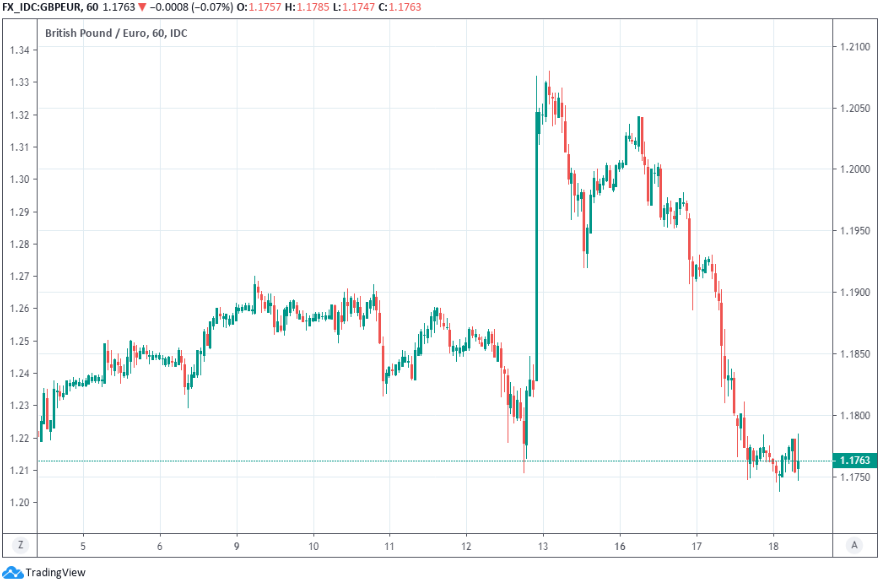British Pound Nears Support against Euro and Dollar but Upside Impetus Is Under Threat
- Written by: James Skinner
-

Image © Pound Sterling Live. Still courtesy of BBC
- GBP finds support after unwinding post-election gains.
- Support seen at 1.3050 against USD, 1.1757 Vs EUR.
- Upside impetus undermined by Johnson's Brexit plan.
- New 'no deal' cliff edge eliminates majority advantage.
- GBP eyes inflation data and implications for BoE rates.
- Odds favouring a BoE rate cut in 2020 are improving.
The Pound was nearing support against the Euro and Dollar on the charts Wednesday but its upside impetus has been undermined by Prime Minister Boris Johnson's construction of a new 'no deal' Brexit cliff edge, which is clouding the outlook for the British currency.
Pound Sterling erased all of its post-election gains in the prior session in response to Boris Johnson's plan to put a legal block on any further delay to the UK's departure from the EU but the currency was finding technical support against the Euro and Dollar around noon on Wednesday.
"GBP/USD is giving back some of its recent gains and nears the October high and December 12 low at 1.3050/13 which are to offer support," says Axel Rudolph, a technical analyst at Commerzbank. "EUR/GBP swiftly bounced off its current December low at .8239 and is now retesting the November low and December 12 high at .8498/.8509 which we expect to cap."
The Pound was quoted at 1.3106 against the Dollar, down from near 1.33 Tuesday but close to the 1.3050 level that Commerzbank sees acting as a floor of support. Meanwhile, the EUR/GBP rate was quoted at 0.8494, close to the resistance threshold identified by Commerzbank. That put the Pound-to-Euro rate at 1.1777 and not far off the 1.1752 support level that equals the 0.8509 resistance barrier in EUR/GBP.

Above: Pound-to-Euro rate shown at hourly intervals.
Johnson's 80 seat majority had led the market to believe he'd be free to soften his Brexit stance and make whatever concessions necessary to deliver his pledge of wrapping up the next phase of negotiations before the end of 2020.
Neither of those possibilities is precluded by Johnson's plan to "legally prohibit" an extension of the transition period beyond the end-2020 but market appetite for the Pound has clearly been curtailed nonetheless.
"The plan to tie his hands on negotiations suggests further downside for GBP into 2020. As noted yesterday, it removes any GBP benefit from the very large Tory majority effectively putting us back in the position we would have been in with a narrow majority bound by hardliners. That makes the bullish GBP consensus for 2020 look increasingly questionable," says Elsa Lignos, head of FX strategy at RBC Capital Markets.
Analysts had upgraded their forecasts for the Pound en masse in the wake of last week's election, believing not only that the threat of a 'no deal' Brexit had been banished for the foreseeable future but also that this and greater certainty over the likely shape of future trade arrangements with the EU would fuel a rebound in business investment next year. This was supposed to fuel more gains for the economy and Sterling but that outlook is now in doubt.
Johnson is expected to bring the Withdrawal Agreement Bill back to parliament on Friday to begin the long process toward ratification of the pact struck between him and Jean-Claude Juncker in October, which is expected to be wrapped up early in the New Year and just in time for the country to formally exit the EU on January 31.
James Forsyth, political editor of The Spectator, reported Wednesday the government intends to get the withdrawal agreement through the House of Commons by January 09. However, the European parliament will not vote on the pact until Wednesday, 29 January. A January exit will give way to another year-long period of negotiations but in the meantime, Sterling will be guided by technical factors on the charts and economic data.
"We have been surprised by how quick the markets have been to readily assume that a sizeable majority would allow the Prime Minister to soften the edges of his Brexit plans," says Kamal Sharma, a strategist at BofA Global Research. "We think the UK will agree to some sort of deal with the EU, but the breadth and scale of that deal remain to be seen. In the meantime, a commitment to leave the EU transitional phase by end 2020 will do nothing to encourage confidence in the UK as an investment opportunity."

Above: Pound-to-Dollar rate shown at hourly intervals.
The Pound was finding support Wednesday when Office for National Statistics data revealed that inflation remained at 1.5% in November while markets were looking for a decline to 1.4%. Core inflation, which is more important in the eyes of central bankers, remained at 1.7% in line with expectations.
However, both consumer price indices are below the 2% target of the Bank of England (BoE) and when combined with the economic and political outlooks, could have implications for interest rates over the coming months.
The economy is widely thought to have slowed further in the final quarter when it was already on track to miss the consensus for growth of only a paltry 1.3% for the year. Slowing growth and below-target inflation come against the backdrop of continuing Brexit risk, which could be enough of an incitement to get the Bank of England talking about 2020 interest rate cuts on Thursday and after subsequent meetings, which might further weigh on the Pound.
"We have been expecting two rate cuts from the Bank of England (BoE) next year for some time. We assume they will wait until well into next year (May) to give time to see how the data evolve post-election," says Robert Wood, an economist at BofA Global Research. " PM Johnson committing to not extend the Brexit transition period supports our base case for weak growth and suggests little reason for the BoE to become more optimistic about an investment rebound. Indeed, it might be a reason for more caution."
The BoE will announce its next rate decision at 12:00 Thursday and markets are not yet prepared for a rate cut.
Pricing in the overnight-index-swap market implies a Bank Rate 0.64% in April 2020, which is below the current 0.75% level but still above the 0.5% that would prevail in the wake of a typical 25 basis point rate cut. And any suggestion from the BoE Thursday or over coming weeks that rates could be cut would likely see the implied rates for 2020 fall and drag the Pound lower with them.
"If global growth failed to stabilise or if Brexit uncertainties remained entrenched, monetary policy might need to reinforce the expected recovery in UK GDP growth and inflation," the BoE said in a November statement.
Time to move your money? The Global Reach Best Exchange Rate Guarantee offers you competitive rates and maximises your currency transfer. Global Reach can offer great rates, tailored transfers, and market insight to help you choose the best times for you to trade. Speaking to a currency specialist helps you to capitalise on positive market shifts and make the most of your money. Find out more here.
* Advertisement





